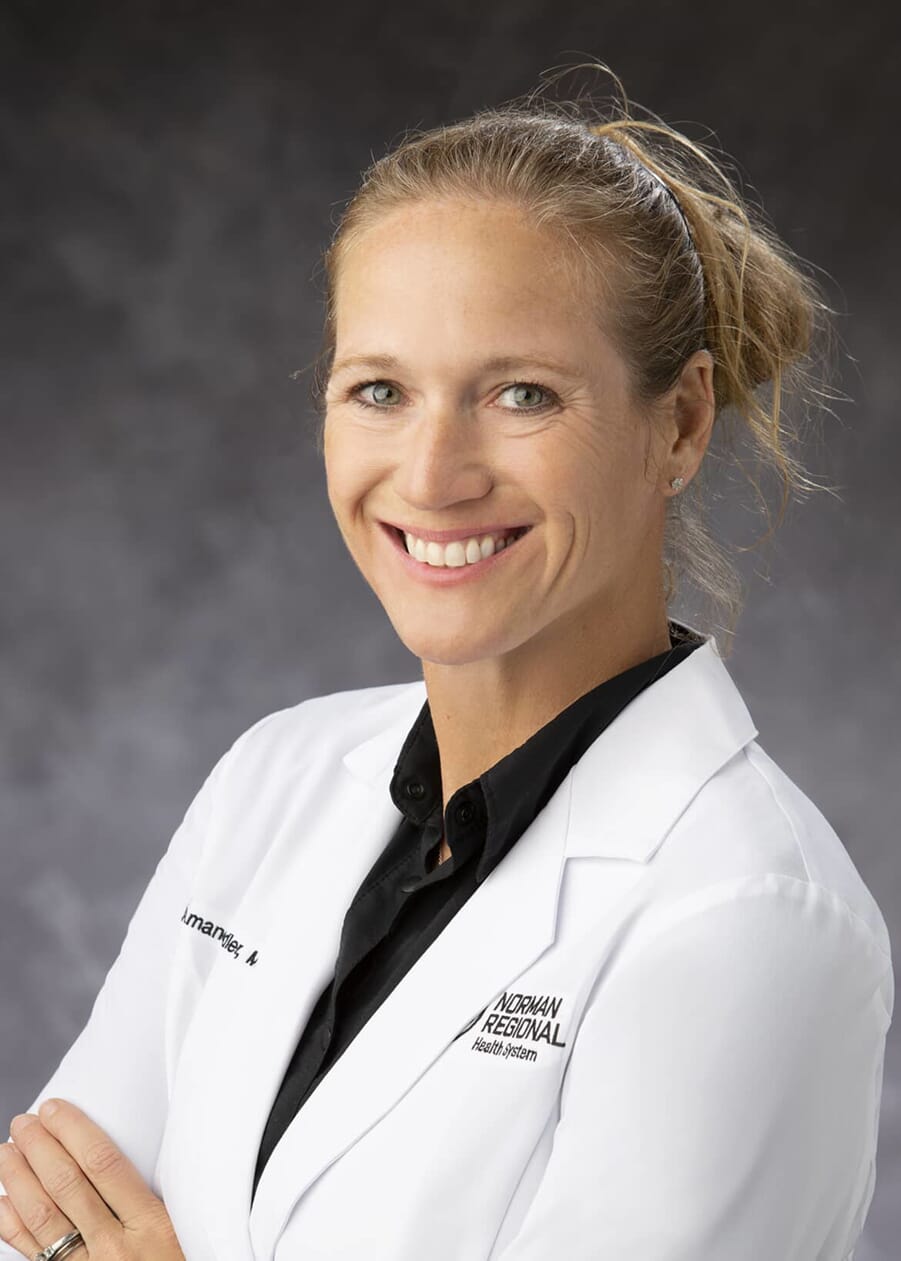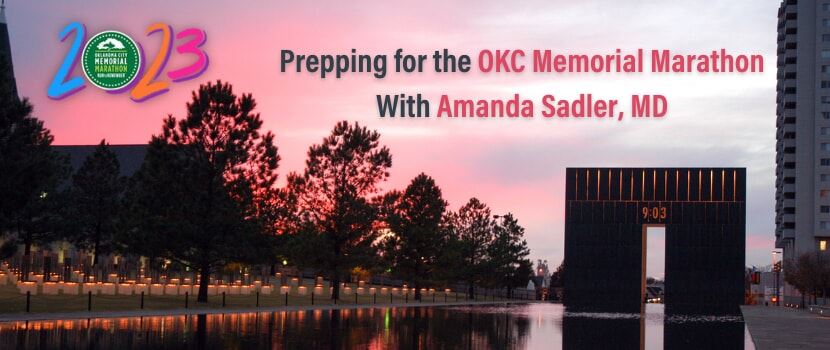The Oklahoma City Memorial Marathon is an annual event that brings together runners from all over the world to honor the victims and survivors of the Oklahoma City bombing. Whether you're a seasoned runner or a first-timer, training for a marathon requires a significant commitment of time, energy, and effort. If there’s anyone who knows the grind of training for an event like the OKC Memorial Marathon, it’s Amanda Sadler, MD. After all, she has completed in it before… in addition to her more than 20 IronMan finishes.
Here are some tips on how to prepare for the OKC Memorial Marathon with Dr. Sadler.
When to Start Training
For a full marathon, ideally you will have already begun training as Dr. Sadler recommends starting your training about 16 weeks prior to the day of the event. If you are doing a half marathon, eight to twelve weeks is recommended. However, these recommendations are for seasoned runners. If you are new to running, it is ideal to add an extra eight weeks to your marathon prep and an additional four weeks to your half marathon prep.
If you are beyond this window of time, don’t let these recommendations stop you from pursuing your goals. These recommendations are the ideal scenario, not the only scenario. Maybe you aren’t trying to break a record, or be competitive, but want to challenge yourself and try new something new. At NMotion, we believe that no goal is too big or too small.
Training and Event Nutrition
Your training leading up to the event is the perfect time to experiment with your diet and figure out what works best for you.
“Try to make some mistakes and see what doesn’t work. I would rather see people make mistakes during their training than on race day,” said Dr. Sadler. “Just because you tried something and it worked on your first run, doesn’t mean it will work again. It’s all about experimenting.”
“If you have your nutrition down during training, that’s what you need to do on race day as well, even if it’s not perfect. This also applies to the night before and breakfast as well. Stick to foods you know you can tolerate” said Dr. Sadler.
Some people stick to liquid nutrition on race day, some people use bars and semi-solid foods like chews and gels that you can do in combination. Usually for a half-marathon, runners can get away with just liquids or gels, but for a full marathon, it is recommended to get some solid food in early on and transition to the gels or liquids later.
.2405071146550.jpg)
It is also crucial to maintain proper hydration before and during the event. Make sure that you salt your food to taste leading up to the event (this means added salt to food just to the point that you can taste the salt). Get potassium from bananas or coconut water. Get magnesium from dark leafy greens or some dark chocolate. Again, make sure you have these variables nailed down during your training phase prior to the event!
OKC Memorial Marathon Aid Station Tips
“Know what you need before you get to the aid station. If you need to slow down and walk to take care of yourself, do it! If it’s hot, grab water and ice right at the end, pour water on your head and then hold the ice in your hand or put under your hat or in your sports bra to help keep you cool,” said Dr. Sadler.
Volunteer groups are located every mile along the course. In addition to entertainment and enthusiastic cheering, each Water Stop provides water and Powerade to participants. Some Water Stops also provide oranges, pretzels and other snacks. Many neighborhoods and other groups set up their own water stops and provide a variety of drink and snack options. GU (energy gel) is available at Water Stop 13. Medical Stations are located every other mile beginning at mile 5, and every mile from mile 19 to the finish. Port-o-Potties are located every mile starting at mile 2.
Training Preparation
The number one priority is just to make sure you are getting enough running training. One factor to consider during a race is the wind. If you live in a windy area like Oklahoma, you’ll probably experience some wind resistance or assistance. You can simulate some of that resistance in training by using a treadmill on an incline setting, which can also help prepare you for any uphill sections of the course. If you’re lucky enough to be assisted by the wind, then that’s just icing on the cake. “The wind is my friend” as Dr. Sadler says!
Weather absolutely matters and unfortunately, the forecasts don’t always tell you the whole story. You can adjust what you are wearing and figure out what works best in cold and warm environments for you. You don’t want to overdress expecting cold weather and get overheated for example.
One thing you can do is wear clothes that are disposable on race day. So instead of wearing your nicest gloves on race day, maybe you opt to wear a cheap pair that you can throw away at an aid station. You can also wear arm/leg warmers or layers that you can remove during the race if needed.

“You can get really specific with your training to prepare for a race, but at the end of the day, running is running,” said Dr. Sadler.
Some other things to consider
NMotion specializes in sports optimization and helping athletes reach their fullest potential. Obviously this includes runners as well. If you have planned out your race preparation and dialed in all the variables you can control, but still feel like you could improve on a few things, NMotion might have something that’s perfect for you.
- Gait Analysis
- Gait analysis is a process that involves analyzing the way a person moves, with a particular focus on the way they walk or run. This analysis can provide valuable information about a runner's biomechanics, which can then be used to improve their running form, prevent injuries, and enhance their performance. Gait Analysis at NMotion will include video analysis on both a standard and motor less TrueForm Treadmill.
- In terms of race preparation, gait analysis can be especially helpful for identifying potential areas of weakness or inefficiency in a runner's form. By addressing these issues in training, runners can work to improve their form and reduce their risk of injury, which can ultimately lead to a better race performance.
- IV Therapy
- IV Therapy can be beneficial for almost anybody, but for runners, it can help a lot with performance, recovery and immunity. It’s cold out, people travel and it can pay off to ensure your immune system is prepared to handle a long race in an outdoor environment.
- You can read more about IV therapy and see available options here.
- Body Composition
- If you’re curious about learning more about your body and how you can optimize your performance or reduce injury risk, body comp can be a helpful way to figure out what’s going on. Body scans also give you an accurate look of your current body composition, allowing you to better track things that are working or not working in your current training and nutrition protocol.
- Nutrition Assessment
- For many athletes, the hardest part isn’t the training or the competition, it’s what’s done in the kitchen. It can be difficult to understand what meal plan works best for you because your body is completely unique to you. If you would like to figure out what an optimal nutrition plan looks like for you, NMotion can help with that!
- Gait analysis is a process that involves analyzing the way a person moves, with a particular focus on the way they walk or run. This analysis can provide valuable information about a runner's biomechanics, which can then be used to improve their running form, prevent injuries, and enhance their performance. Gait Analysis at NMotion will include video analysis on both a standard and motor less TrueForm Treadmill.
The Most Important Piece of Advice from Dr. Sadler
Whether this is your first race or you are a seasoned pro, the most important thing you can do to have a successful race is have fun and enjoy yourself! You have a body capable of doing great things and a race is a great way to celebrate that. Get competitive if that’s your thing, take it easy if you prefer to, but don’t forget to have fun!
About Dr. Sadler

Dr. Sadler graduated from medical school at the University of Oklahoma and completed her residency at the Great Plains Family Medicine Program. She completed her fellowship training through the University of Oklahoma Primary Care Sports Medicine Fellowship program. Dr. Sadler herself comes from an athletic background, participating at the highest levels of competition including being a member of Team USA. Dr. Sadler has earned more than 30 international podium finishes, the world’s fastest IronMan swim time, more than 20 IronMan finishes and has served on the Sam’s Club: Healthy Living Made Simple advisory board, the NCAA Athlete Advisory Committee and the USA Olympic Triathlon Strategic Planning Committee.
If you are interested in scheduling an appointment with Dr. Sadler, you can call 405-515-4040.
Be sure to say hello to Dr. Sadler if you run into her at the marathon!





